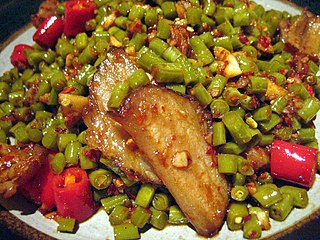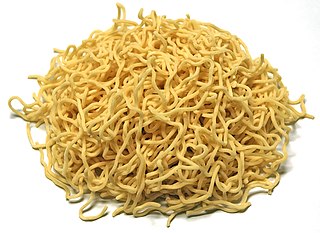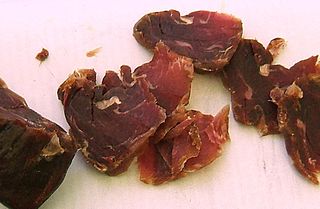
Hunan cuisine, also known as Xiang cuisine, consists of the cuisines of the Xiang River region, Dongting Lake and western Hunan Province in China. It is one of the Eight Great Traditions of Chinese cuisine and is well known for its hot and spicy flavours, fresh aroma and deep colours. Common cooking techniques include stewing, frying, pot-roasting, braising and smoking. Due to the high agricultural output of the region, ingredients for Hunan dishes are many and varied.

Hungarian or Magyar cuisine is the cuisine characteristic of the nation of Hungary and its primary ethnic group, the Magyars. Traditional Hungarian dishes are primarily based on meats, seasonal vegetables, fruits, bread, and dairy products.

Kebab or kabob is a type of cooked meat dish that originates from cuisines of the Middle East. Many variants of the category are popular around the world, including the skewered shish kebab and the doner kebab with bread.

Indonesian cuisine is a collection of various regional culinary traditions that formed the archipelagic nation of Indonesia. There are a wide variety of recipes and cuisines in part because Indonesia is composed of approximately 6,000 populated islands of the total 17,508 in the world's largest archipelago, with more than 1,300 ethnic groups. Many regional cuisines exist, often based upon indigenous culture with some foreign influences. Indonesia has around 5,350 traditional recipes, with 30 of them considered the most important. Indonesia's cuisine may include rice, noodle and soup dishes in modest local eateries to street-side snacks and top-dollar plates.

Service à la française is the practice of serving various dishes of meal at the same time, with the diners helping themselves from the serving dishes. That contrasts to service à la russe in which dishes are brought to the table sequentially and served individually, portioned by servants.
A buffet can be either a sideboard or a system of serving meals in which food is placed in a public area where the diners serve themselves. A form of service à la française, buffets are offered at various places including hotels, restaurants, and many social events. Buffet restaurants normally offer all-you-can-eat food for a set price, but some measure prices by weight or by number of dishes. Buffets usually have some hot dishes, so the term cold buffet has been developed to describe formats lacking hot food. Hot or cold buffets usually involve dishware and utensils, but a finger buffet is an array of foods that are designed to be small and easily consumed only by hand, such as cupcakes, slices of pizza, foods on cocktail sticks, etc.

Flambé is a cooking procedure in which alcohol is added to a hot pan to create a burst of flames. The word means "flamed" in French.

Salisbury steak is a dish originating in the United States and made from a blend of ground beef and other ingredients and usually served with gravy or brown sauce. It is a version of Hamburg steak.

Tableware is any dish or dishware used for setting a table, serving food, and dining. It includes cutlery, glassware, serving dishes, and other items for practical as well as decorative purposes. The quality, nature, variety and number of objects varies according to culture, religion, number of diners, cuisine and occasion. For example, Middle Eastern, Indian or Polynesian food culture and cuisine sometimes limits tableware to serving dishes, using bread or leaves as individual plates. Special occasions are usually reflected in higher quality tableware.

Noodles are a staple of Japanese cuisine. They are often served chilled with dipping sauces, or in soups or hot dishes.

A footman is a male domestic worker employed mainly to wait at table or attend a coach or carriage.

Clay pot cooking is a process of cooking food in a pot made of unglazed or glazed pottery.

In great houses, scullery maids were the lowest-ranked and often the youngest of the female domestic servants and acted as assistant to a kitchen maid.

Anglo-Indian cuisine is the cuisine that developed during the British Raj in India. It was brought to England in the 1930s by the Veeraswamy restaurant, followed by a few others, but not by typical Indian restaurants. The cuisine introduced dishes such as kedgeree, mulligatawny and pish pash to English palates. One of the few Anglo-Indian foods that has had a lasting impact on English cuisine is chutney.

A dish in gastronomy is a specific food preparation, a "distinct article or variety of food", ready to eat or to be served.

Queso flameado is a dish of hot melted cheese and spicy chorizo that is often served flambé. Often compared to cheese fondue, it is a party dish; it is popular at cookouts and in restaurants as an appetizer. Almost unique in Mexican cuisine, in the cuisine of the United States this dish has been widely adapted and is considered a native dish in El Paso. In Mexico, it occurs in restaurants more often in the north. Typical main ingredients are melted cheese and a characteristic meat sauce of loose fresh chorizo, tomato, onion, chile and spices. It is served in a small, shallow casserole or other ceramic or metal heat-proof baking dish. The cheese and sauce are prepared separately, and combined just before serving. This may be done at the table, especially if finished with a flambé: high alcohol liquor is poured on the cheese and ignited, and as it burns the server folds in the sauce. If not flambéed, the mixture may be quickly broiled. Either way, the finished dish is presented while it is still bubbling hot, and it is spooned onto small soft tortillas for individual servings.

Traditional Yamal cuisine is an important part of national culture of Nenets, Khanty and Komi. Yamal is a hunting and fishing land so many dishes include meat, fowl and fish. Berries and mushrooms are also abundant; this accounts for the wealth of "gifts of the forests" on the Yamal table. Presently, Yamal cuisine is renowned for diverse delicacies of Russian cuisine. Yamal hosts enjoy treating their guests with traditional Yamal cuisine and have hot tea which came to Yamal cuisine from Russia. Tea has become the national Yamal beverage, drunk to warm and soothe. Yamal is in northern Russia with frigid winters, so its cuisine should be nourishing to give the people energy to survive during the long winter time. The essential component of Yamal cuisine is warm and hot dishes. Fresh fruits and vegetables are rarely used as they must be imported, as they are not grown in the tundra. The Yamal cuisine is associated with malosol and stroganina. Yamal cuisine has absorbed techniques from other regions. Yamal cuisine is based on reindeer meat and fish of the Yamal rivers, enriched with mushrooms and bread.

Paprika is a spice made from dried and ground red peppers. It is traditionally made from Capsicum annuum varietals in the Longum Group, which also includes chili peppers, but the peppers used for paprika tend to be milder and have thinner flesh. In some languages, but not English, the word paprika also refers to the plant and the fruit from which the spice is made, as well as to peppers in the Grossum Group.

The cayenne pepper is a type of Capsicum annuum. It is usually a moderately hot chili pepper used to flavor dishes. Cayenne peppers are a group of tapering, 10 to 25 cm long, generally skinny, mostly red-colored peppers, often with a curved tip and somewhat rippled skin, which hang from the bush as opposed to growing upright. Most varieties are generally rated at 30,000 to 50,000 Scoville units.

















